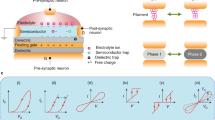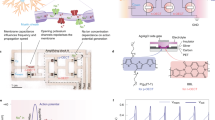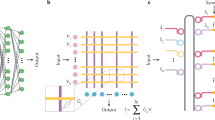Abstract
Reverse engineering the brain by mimicking the structure and function of neuronal networks on a silicon integrated circuit was the original goal of neuromorphic engineering, but remains a distant prospect. The focus of neuromorphic engineering has thus been relaxed from rigorous brain mimicry to designs inspired by qualitative features of the brain, including event-driven signalling and in-memory information processing. Here we examine current approaches to neuromorphic engineering and provide a vision that returns neuromorphic electronics to its original goal of reverse engineering the brain. The essence of this vision is to ‘copy’ the functional synaptic connectivity map of a mammalian neuronal network using advanced neuroscience tools and then ‘paste’ this map onto a high-density three-dimensional network of solid-state memories. Our copy-and-paste approach could potentially lead to silicon integrated circuits that better approximate computing traits of the brain, including low power, facile learning, adaptation, and even autonomy and cognition.
This is a preview of subscription content, access via your institution
Access options
Access Nature and 54 other Nature Portfolio journals
Get Nature+, our best-value online-access subscription
$29.99 / 30 days
cancel any time
Subscribe to this journal
Receive 12 digital issues and online access to articles
$119.00 per year
only $9.92 per issue
Buy this article
- Purchase on Springer Link
- Instant access to full article PDF
Prices may be subject to local taxes which are calculated during checkout




TechInsights (Ray Fontaine, http://rfontaine@techinsights.com; e (right))
Similar content being viewed by others
References
Mead, C. Neuromorphic electronic systems. Proc. IEEE 78, 1629–1636 (1990).
Mead, C. Analog VLSI and Neural Systems (Addison-Wesley, 1989).
Liu, S.-C. & Delbruck, T. Neuromorphic sensory systems. Curr. Opin. Neurobiol. 20, 288–295 (2010).
Lichtsteiner, P., Posch, C. & Delbruck, T. A 128 × 128 120 dB 15 μs latency asynchronous temporal contrast vision sensor. IEEE J. Solid State Circuits 43, 566–576 (2008).
Son, B. et al. A 640 × 480 dynamic vision sensor with a 9 μm pixel and 300 Meps address-event representation. In 2017 IEEE International Solid-State Circuits Conference (ISSCC) 66–67 (IEEE, 2017).
Merolla, P. et al. A million spiking-neuron integrated circuit with a scalable communication network and interface. Science 345, 668–673 (2014).
Zidan, M. A., Strachan, J. P. & Lu, W. D. The future of electronics based on memristive systems. Nat. Electron. 1, 22–29 (2018).
Sheridan, P. M. et al. Sparse coding with memristor networks. Nat. Nanotechnol. 12, 784–790 (2017).
Prezioso, M. et al. Training and operation of an integrated neuromorphic network based on metal-oxide memristors. Nature 521, 61–64 (2015).
Alibart, F., Zamanidoost, E. & Strukov, D. B. Pattern classification by memristive crossbar circuits using ex situ and in situ training. Nat. Commun. 4, 2072 (2013).
Ambrogio, S. et al. Equivalent-accuracy accelerated neural-network training using analogue memory. Nature 558, 60–67 (2018).
Choi, S., Shin, J. H., Lee, J., Sheridan, P. & Lu, W. D. Experimental demonstration of feature extraction and dimensionality reduction using memristor networks. Nano Lett. 17, 3113–3118 (2017).
Wang, Z. et al. Resistive switching materials for information processing. Nat. Rev. Mater. 5, 173–195 (2020).
Lin, P. et al. Three-dimensional memristor circuits as complex neural networks. Nat. Electron. 3, 225–232 (2020).
Wang, Z. et al. Reinforcement learning with analogue memristor arrays. Nat. Electron. 2, 115–124 (2019).
Li, C. et al. Analogue signal and image processing with large memristor crossbars. Nat. Electron. 1, 52–59 (2018).
Jang, H. et al. An atomically thin optoelectronic machine vision processor. Adv. Mater. 32, 2002431 (2020).
Mahowald, M. & Douglas, R. A silicon neuron. Nature 354, 515–518 (1991).
Indiveri, G. et al. Neuromorphic silicon neuron circuits. Front. Neurosci. 5, 73 (2011).
Ryckebusch, S., Bower, J. M. & Mead, C. Modeling small oscillating biological networks in analog VLSI. Adv. Neural Inf. Process. Syst. 1, 384–393 (1989).
Hahnloser, R. H. R., Sarpeshkar, R., Mahowald, M., Douglas, R. & Seung, H. S. Digital selection and analogue amplification coexist in a cortex-inspired silicon circuit. Nature 405, 947–951 (2000).
Mahowald, M. & Mead, C. The silicon retina. Sci. Am. 264, 76–82 (1991).
Abbott, J. et al. A nanoelectrode array for obtaining intracellular recordings from thousands of connected neurons. Nat. Biomed. Eng. 4, 232–241 (2020).
Kim, K. Silicon technologies and solutions for the data-driven world. In 2015 IEEE International Solid-State Circuits Conference (ISSCC) 8–14 (IEEE, 2015).
LeCun, Y., Bengio, Y. & Hinton, G. Deep learning. Nature 521, 436–444 (2015).
Song, J. et al. An 11.5TOPS/W 1024-MAC butterfly structure dual-core sparsity-aware neural processing unit in 8 nm flagship mobile SoC. In 2019 IEEE International Solid-State Circuits Conference (ISSCC) 130–131 (IEEE, 2019).
Wang, Z. et al. Fully memristive neural networks for pattern classification with unsupervised learning. Nat. Electron. 1, 137–145 (2018).
Ambrogio, S. et al. Unsupervised learning by spike timing dependent plasticity in phase change memory (PCM) synapses. Front. Neurosci. 10, 56 (2016).
Alivisatos, P. et al. Nanotools for neuroscience and brain activity mapping. ACS Nano 7, 1850–1866 (2013).
Lin, M. Z. & Schnitzer, M. J. Genetically encoded indicators of neuronal activity. Nat. Neurosci. 19, 1142–1153 (2016).
Cazemier, J. L., Clasca, F. & Tiesinga, P. H. E. Connectomic analysis of brain networks: novel techniques and future directions. Front. Neuroanat. 10, 110 (2016).
White, J. G., Southgate, E., Thomson, J. N. & Brenner, S. The structure of the nervous system of the nematode Caenorhabditis elegans. Phil. Trans. R. Soc. B 314, 1–340 (1986).
Scheffer, L. K. et al. A connectome and analysis of the adult Drosophila central brain. eLife 9, e57443 (2020).
Sasaki, T., Minamisawa, G., Takahashi, N., Matsuki, N. & Ikegaya, Y. Reverse optical trawling for synaptic connections in situ. J. Neurophysiol. 102, 636–643 (2009).
Petreanu, L., Huber, D., Sobczyk, A. & Svoboda, K. Channelrhodopsin-2-assisted circuit mapping of long-range callosal projections. Nat. Neurosci. 10, 663–668 (2007).
Shemesh, O. A. et al. Temporally precise single-cell-resolution optogenetics. Nat. Neurosci. 20, 1796–1806 (2017).
Jäckel, D. et al. Combination of high-density microelectrode array and patch clamp recordings to enable studies of multisynaptic integration. Sci. Rep. 7, 978 (2017).
Perin, R., Berger, T. K. & Markram, H. A synaptic organizing principle for cortical neuronal groups. Proc. Natl Acad. Sci. USA 108, 5419–5424 (2011).
Frey, U. et al. Switch-matrix-based high-density microelectrode array in CMOS technology. IEEE J. Solid State Circuits 45, 467–482 (2010).
Tsai, D., Sawyer, D., Bradd, A., Yuste, R. & Shepard, K. L. A very large-scale microelectrode array for cellular-resolution electrophysiology. Nat. Commun. 8, 1802 (2017).
Abbott, J. et al. The design of a CMOS nanoelectrode array with 4096 current-clamp/voltage-clamp amplifiers for intracellular recording/stimulation of mammalian neurons. IEEE J. Solid State Circuits 55, 2567–2582 (2020).
Abbott, J. et al. CMOS nanoelectrode array for all-electrical intracellular electrophysiological imaging. Nat. Nanotechnol. 12, 460–466 (2017).
Robinson, J. T. et al. Vertical nanowire electrode arrays as a scalable platform for intracellular interfacing to neuronal circuits. Nat. Nanotechnol. 7, 180–184 (2012).
Jun, J. J. et al. Fully integrated silicon probes for high-density recording of neural activity. Nature 551, 232–236 (2017).
Sanes, J. R. & Zipursky, S. L. Design principles of insect and vertebrate visual systems. Neuron 66, 15–36 (2010).
Wilson, D. A. & Sullivan, R. M. Cortical processing of odor objects. Neuron 72, 506–519 (2011).
Lee, Y. K. et al. Embedded STT-MRAM in 28-nm FDSOI logic process for industrial MCU/IoT application. In 2018 IEEE Symposium on VLSI Technology 181–182 (IEEE, 2018).
Chung, H. et al. A 58 nm 1.8 V 1 Gb PRAM with 6.4 MB/s program BW. In 2011 IEEE International Solid-State Circuits Conference (ISSCC) 500–501 (IEEE, 2011).
Fackenthal, R. et al. A 16 Gb ReRAM with 200 MB/s write and 1 GB/s read in 27 nm technology. In 2014 IEEE International Solid-State Circuits Conference (ISSCC) 338–339 (IEEE, 2014).
Lee, M.-J. et al. A fast, high-endurance and scalable non-volatile memory device made from asymmetric Ta2O5–x/TaO2–x bilayer structures. Nat. Mater. 10, 625–630 (2011).
Xu, R. et al. Vertical MoS2 double layer memristor with electrochemical metallization as an atomic-scale synapse with switching thresholds approaching 100 mV. Nano Lett. 19, 2411–2417 (2019).
Jo, S. H. et al. Nanoscale memristor device as synapse in neuromorphic systems. Nano Lett. 10, 1297–1301 (2010).
Park, K.-T. et al. Three-dimensional 128 Gb MLC vertical NAND flash-memory with 24-WL stacked layers and 50 MB/s high-speed programming. In 2014 IEEE International Solid-State Circuits Conference (ISSCC) 334–335 (IEEE, 2014).
Du, C., Ma, W., Chang, T., Sheridan, P. & Lu, W. D. Biorealistic implementation of synaptic functions with oxide memristors through internal ionic dynamics. Adv. Funct. Mater. 25, 4290–4299 (2015).
Kim, S. et al. Experimental demonstration of a second-order memristor and its ability to biorealistically implement synaptic plasticity. Nano Lett. 15, 2203–2211 (2015).
Wang, Z. et al. Memristors with diffusive dynamics as synaptic emulators for neuromorphic computing. Nat. Mater. 16, 101–108 (2017).
Kuzum, D., Jeyasingh, R. G. D., Lee, B. & Wong, H.-S. P. Nanoelectronic programmable synapses based on phase change materials for brain-inspired computing. Nano Lett. 12, 2179–2186 (2012).
Marx, V. Neuroscience waves to the crowd. Nat. Methods 10, 1069–1074 (2013).
Kim, D.-W. & Hwang, T. The future of advanced package solutions. In 2019 IEEE Symposium on VLSI Technology 48–49 (IEEE, 2019).
Kandel, E. R., Schwartz, J. H., Jessell, T. M., Siegelbaum, S. A. & Hudspeth, A. J. Principles of Neural Science 5th edn (McGraw-Hill, 2012).
Bock, D. D. et al. Network anatomy and in vivo physiology of visual cortical neurons. Nature 471, 177–182 (2011).
Briggman, K. L. & Bock, D. D. Volume electron microscopy for neuronal circuit reconstruction. Curr. Opin. Neurobiol. 22, 154–161 (2012).
Briggman, K. L., Helmstaedter, M. & Denk, W. Wiring specificity in the direction-selectivity circuit of the retina. Nature 471, 183–188 (2011).
Kleinfeld, D. et al. Large-scale automated histology in the pursuit of connectomes. J. Neurosci. 31, 16125–16138 (2011).
Lichtman, J. W. & Sanes, J. R. Ome sweet ome: what can the genome tell us about the connectome? Curr. Opin. Neurobiol. 18, 346–353 (2008).
Morgan, J. L. & Lichtman, J. W. Why not connectomics? Nat. Methods 10, 494–500 (2013).
Berdan, R. et al. Emulating short-term synaptic dynamics with memristive devices. Sci. Rep. 6, 18639 (2016).
Kim, M.-K. & Lee, J.-S. Short-term plasticity and long-term potentiation in artificial biosynapses with diffusive dynamics. ACS Nano 12, 1680–1687 (2018).
Acknowledgements
We thank S. J. Kim, S. Jung, H. Lee and H. Kim of Samsung Advanced Institute of Technology, J. Abbott, T. Ye, K. Krenek, R. Gertner, S. Ban, Y. Kim, L. Qin, W. Wu, R. Xu, H. S. Jung and J. Wang of Harvard University and H. J. Baek (Executive Vice President), J. Song (Executive Vice President), K. Choi (Senior Vice President), S. Yoon (Vice President), T. Hwang, J. Lim, D. Kwon, Y. Kim and J. Kim of Samsung Electronics for discussions, advice and/or contributions to materials used here from original research articles.
Author information
Authors and Affiliations
Contributions
D.H., H.P., S.H. and K.K. conceived this Perspective. D.H., H.P., S.H. and K.K. wrote the manuscript.
Corresponding authors
Ethics declarations
Competing interests
The authors declare no competing interests.
Additional information
Peer review information Nature Electronics thanks Yoeri van de Burgt and Huaqiang Wu for their contribution to the peer review of this work.
Publisher’s note Springer Nature remains neutral with regard to jurisdictional claims in published maps and institutional affiliations.
Rights and permissions
About this article
Cite this article
Ham, D., Park, H., Hwang, S. et al. Neuromorphic electronics based on copying and pasting the brain. Nat Electron 4, 635–644 (2021). https://doi.org/10.1038/s41928-021-00646-1
Received:
Accepted:
Published:
Issue Date:
DOI: https://doi.org/10.1038/s41928-021-00646-1
This article is cited by
-
The Roadmap of 2D Materials and Devices Toward Chips
Nano-Micro Letters (2024)
-
Nanograin network memory with reconfigurable percolation paths for synaptic interactions
Light: Science & Applications (2023)
-
Tomography of memory engrams in self-organizing nanowire connectomes
Nature Communications (2023)
-
Achieving nanoscale precision using neuromorphic localization microscopy
Nature Nanotechnology (2023)
-
Integrated opposite charge grafting induced ionic-junction fiber
Nature Communications (2023)



